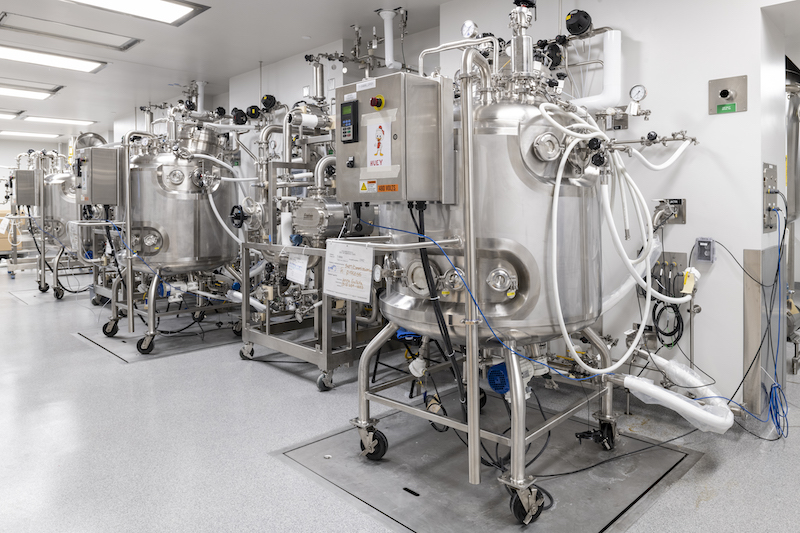More than two-thirds of U.S. households own at least one pet, and more than half own dogs. The American Pet Association estimates that Americans spent a record $99 billion on pet-related expenses in 2020, from food and toys to vet services. The animal care sector is big business that at least one AEC firm has been tapping into for a while.
CRB, headquartered in the heart of the so-called animal health corridor in Kansas City, Mo., has cultivated a specialty for working on biotech facilities that focus on the animal world. In that capacity, CRB has collaborated with a several other AEC firms, such as ESG and Power Construction on Fulton Labs, a life sciences campus in Chicago’s Fulton Market neighborhood. The campus hosts 724,714 rentable sf of dedicated lab and office space with an additional 57,000 sf of top-tier amenity space including a community garden, wellness center and stunning rooftop lounge.
Eric Danielson, CRB’s Director of Business Development, says that growth in this industry sector is coming from several directions that include the post-COVID study of monoclonal antibodies in animals. He adds that there’s also a lot of interest in gene and cell therapies, especially for companion pets. And on the food side, manufacturers are exploring “fresher options” that consumers are demanding and are willing to spend more on. These include alternative protein food types and products that can be sold less expensively at retail.
Danielson says his company is seeing more manufacturers take a holistic approach to animal health by, for example, getting into food products with pharmaceutical elements embedded into the ingredients.

CRB provided design services for this new 96,000-sf animal health biological production facility used to manufacture aerobe bacterins and viral antigens.
MULTIPLE REGULATORY BODIES
Animal care is a highly regulated business that, in the U.S., is overseen by the Food & Drug Administration and the Department of Agriculture. CRB has also worked for clients in Europe, South America, and Asia, each with its own rules and regs. So a big part of CRB’s job, says Danielson, is to make sure that its clients’ projects adhere to their markets’ regulatory requirements.
CRB relies mightily on reality capture, through BIM and Virtual Design and Construction (VDC) to, in Danielson’s words, “provide a digital understanding of the design for the day-to-day user.” These tools also reduced the need for physical on-site visits during the coronavirus pandemic, and are getting clients’ projects up and running faster at a time when speed to market is a critical competitive component.
IPD PRACTITIONER

A CRB employee on-site during the construction phase of a ONEsolution project for a major global animal health company.
To that end, within the past year CRB has rolled out SlateXpace, a platformed modular solution, primarily for multimodal facilities, whose plug-and-play components can be deployed without needing to shut down other parts of the building. “It reduces down time,” says Danielson. (A short video that illustrates how this works can be viewed here.)
CRB is also a proponent of Integrated Project Delivery (IPD) through its ONEsolution approach that brings together the company’s team of designers, engineers, and other experts to control quality, cost, and scheduling by focusing on lean project delivery based on core principles that optimize the client’s capital investment through improved execution, with shared risks and rewards.
Danielson—whose 20-plus years in the AEC space included stints with J.E. Dunn and as a municipal planner—says that his firm strives to avoid “falling into the trap of repeating the same production design standards. This limits innovation.” It is also always looking for ways to eliminate steps for a project to achieve regulatory compliance.
With regard to innovation and fresh thinking, a few weeks ago CRB elected four new members to its Board of Directors, three of whom are from outside the company, its first election of external members. "Together, their insights and fresh perspectives will challenge and strengthen us, resulting in continued high value for our clients and rewarding experiences for our employees," said Ryan Schroeder, CRB’s President.
The outside board members include Tim Hannan, Executive Vice President and CFO of New-Press & Gazette Company; Sandy Price, a retired Senior Vice President of Human Resources at Sprint; and Bob Uhler, a philanthropist and former Chairman of Great Lakes Dredge and Dock.
Related Stories
| Jan 27, 2011
Perkins Eastman's report on senior housing signals a changing market
Top international design and architecture firm Perkins Eastman is pleased to announce that the Perkins Eastman Research Collaborative recently completed the “Design for Aging Review 10 Insights and Innovations: The State of Senior Housing” study for the American Institute of Architects (AIA). The results of the comprehensive study reflect the changing demands and emerging concepts that are re-shaping today’s senior living industry.
| Jan 21, 2011
Harlem facility combines social services with retail, office space
Harlem is one of the first neighborhoods in New York City to combine retail with assisted living. The six-story, 50,000-sf building provides assisted living for residents with disabilities and a nonprofit group offering services to minority groups, plus retail and office space.
| Jan 21, 2011
Research center built for interdisciplinary cooperation
The Jan and Dan Duncan Neurological Research Institute at Texas Children’s Hospital, in Houston, the first basic research institute for childhood neurological diseases, is a 13-story twisting tower in the center of the hospital campus.
| Jan 19, 2011
Biomedical research center in Texas to foster scientific collaboration
The new Health and Biomedical Sciences Center at the University of Houston will facilitate interaction between scientists in a 167,000-sf, six-story research facility. The center will bring together researchers from many of the school’s departments to collaborate on interdisciplinary projects. The facility also will feature an ambulatory surgery center for the College of Optometry, the first of its kind for an optometry school. Boston-based firms Shepley Bulfinch and Bailey Architects designed the project.
| Jan 19, 2011
New Fort Hood hospital will replace aging medical center
The Army Corps of Engineers selected London-based Balfour Beatty and St. Louis-based McCarthy to provide design-build services for the Fort Hood Replacement Hospital in Texas, a $503 million, 944,000-sf complex partially funded by the American Recovery and Reinvestment Act. The firm plans to use BIM for the project, which will include outpatient clinics, an ambulance garage, a central utility plant, and three parking structures. Texas firms HKS Architects and Wingler & Sharp will participate as design partners. The project seeks LEED Gold.
| Jan 10, 2011
Michael J. Alter, president of The Alter Group: ‘There’s a significant pent-up demand for projects’
Michael J. Alter, president of The Alter Group, a national corporate real estate development firm headquartered in Skokie, Ill., on the growth of urban centers, project financing, and what clients are saying about sustainability.
| Dec 17, 2010
ARRA-funded Navy hospital aims for LEED Gold
The team of Clark/McCarthy, HKS Architects, and Wingler & Sharp are collaborating on the design of a new naval hospital at Camp Pendleton in Southern California. The $451 million project is the largest so far awarded by the U.S. Navy under the American Recovery and Reinvestment Act. The 500,000-sf, 67-bed hospital, to be located on a 70-acre site, will include facilities for emergency and primary care, specialty care clinics, surgery, and intensive care. The Building Team is targeting LEED Gold.
| Dec 17, 2010
Arizona outpatient cancer center to light a ‘lantern of hope’
Construction of the Banner MD Anderson Cancer Center in Gilbert, Ariz., is under way. Located on the Banner Gateway Medical Center campus near Phoenix, the three-story, 131,000-sf outpatient facility will house radiation oncology, outpatient imaging, multi-specialty clinics, infusion therapy, and various support services. Cannon Design incorporated a signature architectural feature called the “lantern of hope” for the $90 million facility.
| Oct 18, 2010
World’s first zero-carbon city on track in Abu Dhabi
Masdar City, the world’s only zero-carbon city, is on track to be built in Abu Dhabi, with completion expected as early as 2020. Foster + Partners developed the $22 billion city’s master plan, with Adrian Smith + Gordon Gill Architecture, Aedas, and Lava Architects designing buildings for the project’s first phase, which is on track to be ready for occupancy by 2015.
| Oct 13, 2010
Prefab Trailblazer
The $137 million, 12-story, 500,000-sf Miami Valley Hospital cardiac center, Dayton, Ohio, is the first major hospital project in the U.S. to have made extensive use of prefabricated components in its design and construction.















